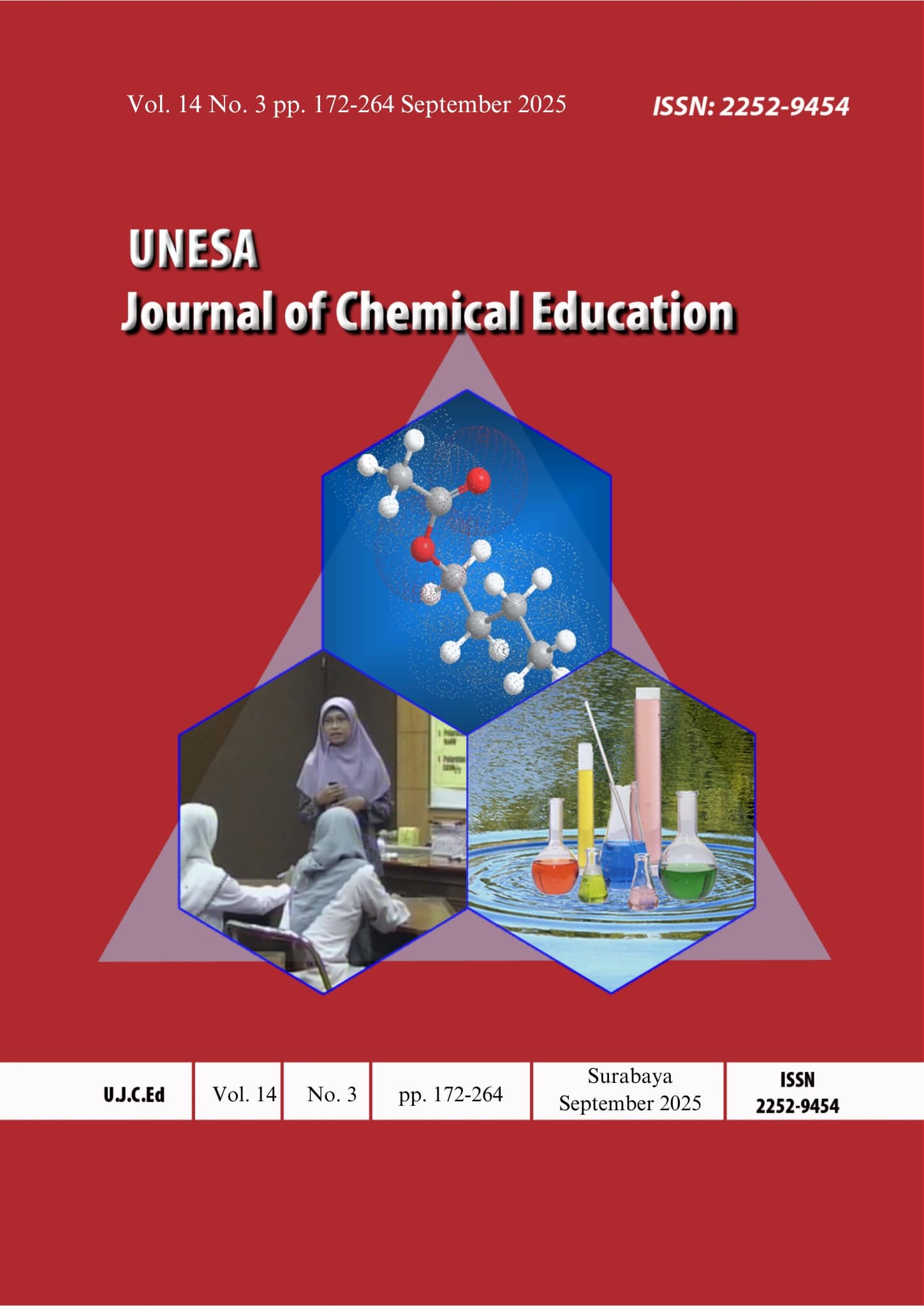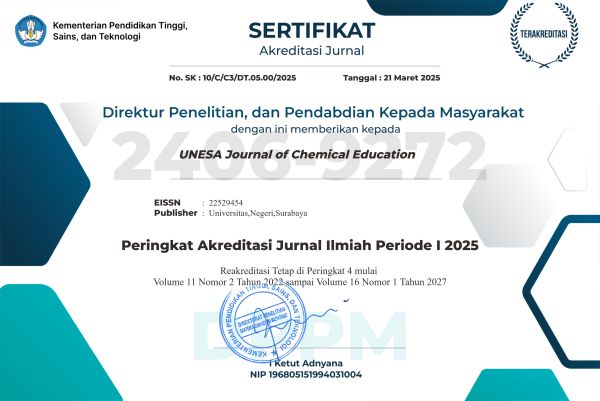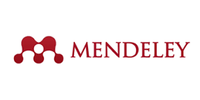DEVELOPMENT OF STUDENT ACTIVITY SHEET (SAS) USING MIND MAPPING STRATEGIES TO IMPROVE CREATIVE THINKING SKILLS ON ATOMIC MATERIALS AND NANOTECHNOLOGY
DOI:
https://doi.org/10.26740/ujced.v14n3.p210-219Keywords:
mind mapping, creative thinking skills, atoms and nanotechnology, Student Activity Sheet (SAS)Abstract
This study aims to obtain a suitable SAS to improve students' creative thinking skills. This type of research includes research and development. The development of the model used refers to the 4-D model but is only limited to the stages of determination, design, and development. Trial activities were carried out on 34 students of class XE-3. The feasibility of the developed SAS is guided by validity, practicality, and effectiveness. Validation was carried out by expert validators with scores determined based on the mode value. The results of the study showed the feasibility of the teaching module in terms of content validity and construct validity which obtained modes 4 and 5 in each aspect with valid and very valid categories so that overall the teaching module obtained a mode ≥4 and was declared valid. The results of the practicality analysis were seen from the student response questionnaire and observations of student activities. The percentage of practicality based on the student response questionnaire and student observations was obtained at 92.01% with a very practical category. Meanwhile, the observation results of student activities obtained relevant activities at meeting 1 of 97.62% and meeting 2 97.37%. From the three percentages obtained the percentage of relevant participant activities was increased by 97.5% so that it can be said that the SAS was developed very practically. The results of the analysis of the effectiveness of SAS were measured based on the increase in students' creative thinking skills through the pretest and posttest mind map as well as questions about understanding creative thinking skills on chemical bonding material with N-gain values obtained respectively of 0.73 and 0.72 with a high category. Based on the results of validity, practicality and effectiveness, the mind map strategy teaching module is suitable for use as a learning tool to improve creative thinking skills on atomic and nanotechnology materials.
Downloads
References
Zubaidah, S. 2016. Keterampilan Abad Ke -21: Ketrampilan yang Diajarkan Melalui Pembelajaran. Jakarta: Pustaka Pelajar.
Pertiwi, A. D., Nurfatimah, S. A., and Hasna, S. 2022. Menerapkan Metode Pembelajaran Berorientasi Student Centered Menuju Masa Transisi Kurikulum Merdeka. Jurnal Pendidikan Tambusai, Vol. 6, No. 1, pp. 8839‒8848.
Hidayat, A., and Sari, D. P. 2021. Analisis Kesulitan Belajar Siswa pada Materi Struktur Atom dan Solusi Pembelajarannya. Jurnal Pendidikan Kimia Indonesia, Vol. 5, No. 1, pp. 45‒53.
Handayani, S., Rahayu, S., and Suhendra, L. 2022. Penerapan Strategi Mind Mapping dalam Pembelajaran Kimia untuk Meningkatkan Pemahaman Konsep Siswa. Jurnal Pendidikan Sains Indonesia, Vol. 10, No. 2, pp. 234–241.
Ningrum, A. S. 2022. Pengembangan Perangkat Pembelajaran Kurikulum Merdeka Belajar (Metode Belajar). Prosiding Pendidikan Dasar, Vol. 1, No. 1, pp. 137–144.
Ahmar, D. S. 2016. Hubungan antara Kemampuan Awal dengan Kemampuan Berpikir Kreatif dalam Kimia Peserta Didik Kelas XI IPA SMA Negeri Se Kabupaten Takalar. Sainsmat: Jurnal Ilmiah Ilmu Pengetahuan Alam, Vol. 5, No. 2, pp. 157–164.
Marwiyah, S., Kamid, and Risnita. 2015. Pengembangan Instrumen Penilaian Keterampilan Berpikir Kreatif pada Pelajaran IPA Terpadu Materi Atom, lon, dan Molekul SMP Islam Al Falah. Edu-Sains, Vol. 4, No. 1, pp. 26‒31.
Sulistiowati, E., and Mitarlis. 2021. Lembar Kerja Peserta Didik (LKPD) dengan Strategi Mind Mapping untuk Melatihkan Keterampilan Berpikir Kreatif pada Materi Redoks Kelas X. UNESA Journal of Chemical Education, Vol. 10, No. 2, pp. 185–194.
Sanjaya, W. 2008. Strategi Pembelajaran: Berorientasi Standar Proses Pendidikan. Jakarta: Kencana Prenada Media Group.
Fatimah, F., and Kartikasari, D. 2018. Strategi Pembelajaran yang Efektif dalam Meningkatkan Keterampilan Peserta Didik. Jurnal Pendidikan Strategis, Vol. 5, No. 1, pp. 45–58.
Anggreani, P., and Mitarlis. 2021. Lembar Kerja Peserta Didik (LKPD) Berorientasi Mind Mapping untuk Melatihkan Keterampilan Berpikir Kreatif pada Materi Asam Basa. UNESA Journal of Chemical Education, Vol. 10, No. 2, pp. 131–139.
Sugiyono. 2015. Metode Penelitian Pendidikan (Pendekatan Kuantitatif, Kualitatif dan R&D). Bandung: CV Alfabeta.
Riduwan. 2015. Skala Pengukuran Variabel-Variabel Penelitian. Bandung: Alfabeta.
Lutfi, A. 2021. Research and Development (R&D): Implikasi dalam Pendidikan Kimia. Surabaya: Jurusan Kimia FMIPA Universitas Negeri Surabaya.
Hake, R. 1999. Analyzing Change/Gain Score. Americans Educational Research Association's Division Measurement and Research Methodology.
Downloads
Published
Issue
Section
License
Copyright (c) 2025 UNESA Journal of Chemical Education

This work is licensed under a Creative Commons Attribution-NonCommercial 4.0 International License.
The license terms of the Creative Commons Attribution-NonCommercial 4.0 International (CC BY-NC 4.0) requires attribution to the original creator, permits non-commercial use, and does not allow for the application of legal or technological restrictions on others' use.
 Abstract views: 47
,
Abstract views: 47
, PDF Downloads: 38
PDF Downloads: 38













